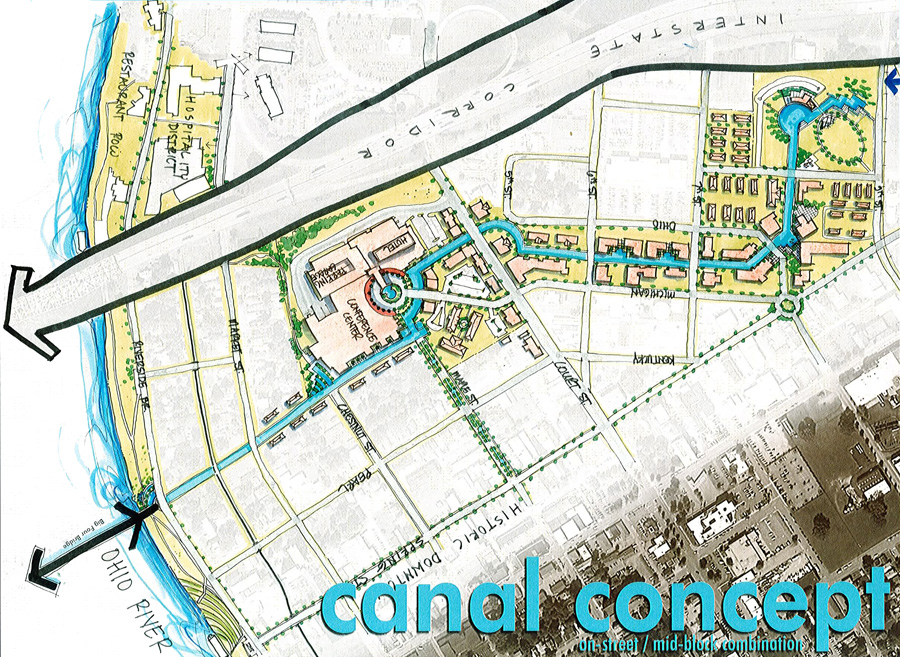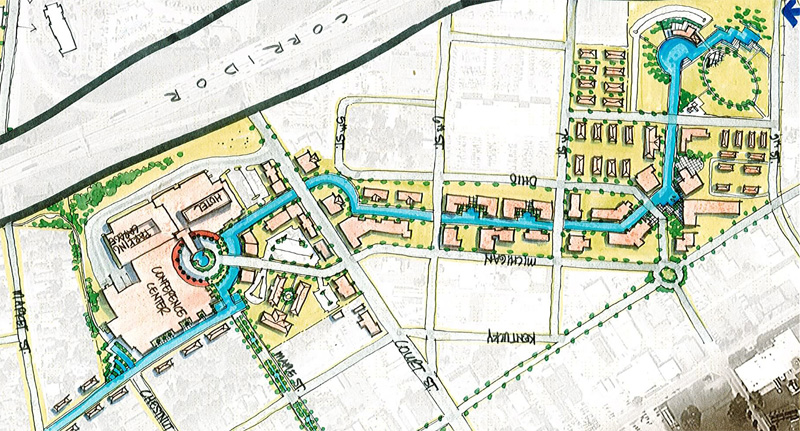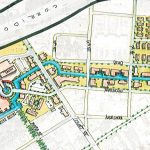
The City of Jeffersonville unveiled the winning entry in a competition to design the new logo for the Jeffersonville Canal District this week, but excitement for the proposed canal we first told you about last August has been growing for some time.
The general idea grew out of a practical problem: dealing with excess rainwater in the sewers that causes Combined Sewer Overflow (CSO) to pour into the Ohio River. The EPA required Jeffersonville to do something about the problem and, rather than go the traditional route of building a gigantic underground tube, Mayor Tom Galligan proposed an open canal that could store rainwater and channel it to the Ohio River while simultaneously cleaning the water and attracting tourists.


The canal is estimated to cost $52 million, would travel about 3,300 feet through Jeffersonville just west of its historic Downtown, and could be finished in 10 years. The canal would measure 40 feet wide by four feet deep. It would connect planned developments such as a convention center and hotel and the approach to the Big Four Pedestrian & Bike Bridge.
Here’s some background on how the canal would work from the News & Tribune:
Herriford said the canal would be recessed into the ground, allowing gravity to deliver water from a detention pond between Seventh Street and Ninth Street down to the Ohio River. The canal would be 4-feet deep at all points, the study said. And there would be 20-foot wide walkways on each side, surrounded by retaining walls.
During wet weather an automatic gate would open, allowing an increased-amount of rainwater to flow directly into the Ohio River. The harder the rain, the more the gate would open, Herriford said. During dry weather, water would move slower but would be kept flowing with stored rainwater, recycled water, cooling water pumped out of industries and groundwater, he said.
The canal would have either raised bridges or culverts where it intersected streets, depending on how much the city wants to spend.
In late April, Jeffersonville put out a Request for Qualifications (RFQ) to find firms to undertake the project including creating a master plan, coordinating various components of canal planning and construction, and potentially developing a convention center. Responses are due back on May 29 and the city will announce the results on June 30.
The exact route for the canal still hasn’t been finalized, but a concept plan shows the canal winding through the city as you can see on the diagrams. A map submitted as part of the RFQ shows the route meandering back and forth without any defined geometry, but once a team is assembled, the proposal will begin to be finalized under a master plan.
The News & Tribune took a driving tour of the conceptual route seen in the diagrams above and below. Here’s a look at where the canal could be situated in Jeffersonville:
A feasibility study for the project revealed that the canal would be twice as effective as the underground sewer alternative while saving $7 million. Further, it showed that the project could be paid for without raising taxes. Instead, Jeffersonville will use sewer fees, grants, and redevelopment money to fund the project.
Already, the city has begun digging a retention basin that will handle excess storm-water in the short term and could be converted into a pool at the inland terminus of the canal. The basin will be surrounded by a five-acre park.
I think we really need to applaud Jeffersonville for such innovative out-of-the-box thinking. The canal demonstrates that the city is prepared to tackle the interrelatedness of major issues such as its sewer and flooding problem, economic development, urban design, sustainability, recreation, tourism, and civic beautification. All that packed into a single proposal.
This kind of approach should be fostered in the region to solve interrelated big problems rather than looking at each issue individually and losing the big picture. Too often, our leaders can’t see the forest for the trees. (This whole thing reminds me of the 8664.org proposal.) I personally can’t wait to see this project move ahead.
The Jeffersonville Canal District has attracted the attention of a couple high profile media sources as well. Here’s an article I wrote in the The Architect’s Newspaper last year and a corresponding write up on The Dirt, the blog of the American Society of Landscape Architects.







This idea sounds really intriguing, wholly innovative and fully attractive. I hope this can come to fruition, but I do wonder a couple of things: what will keep the water clean and what happens in cold weather when the temperature is below freezing?
Thank you for following this story. I think the concept is a great idea and I would love to see the end result.
Very fun!
This is such an excellent idea! I love that Jefferville Officals actually ask the question "Why just make something that functions? Let's make something special!" I can't wait to see it completed.